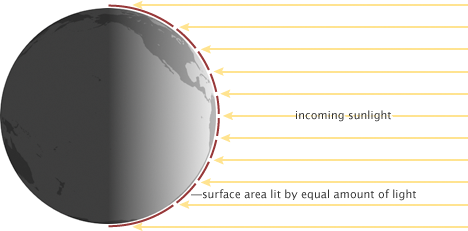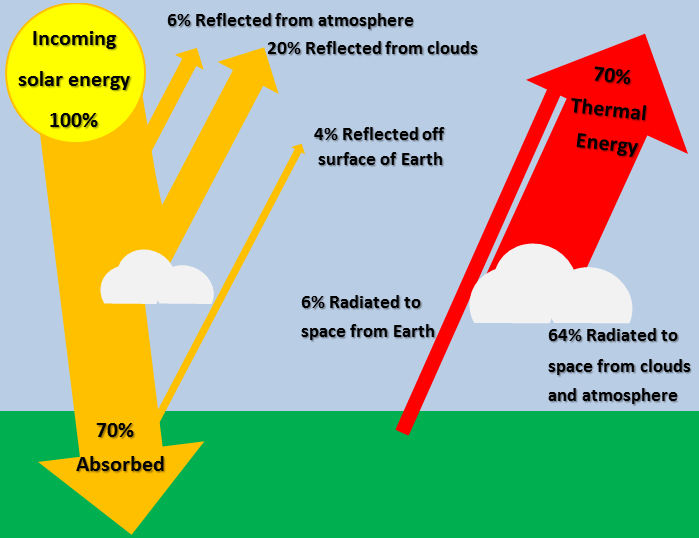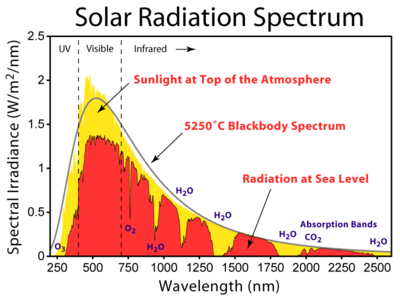what happens to most solar radiation when it reaches the surface of the earth

Figure 1. The Lord's day is the major source of energy and vital to life on Earth, but much of its light is reflected. Solar energy acts as a chief free energy flow that can be harnessed.[1]
Nearly all of the Earth'southward free energy input comes from the sun. Not all of the sunlight that strikes the top of the temper is converted into energy at the surface of the Earth. The Solar energy to the Earth refers to this energy that hits the surface of the Globe itself. The amount of energy that reaches the the Earth provides a useful agreement of the energy for the Earth as a organisation. This energy goes towards weather, keeping the temperature of the Earth at a suitable level for life, and powers the unabridged biosphere. Additionally, this solar energy can be used for solar power either with solar thermal power plants or photovoltaic cells.
Computing Solar Energy to Surface
Energy from Sun to Earth
The Sun is mostly considered to produce a constant amount of power (although there are small variances in the output energy depending on sunspot cycles) with a surface intensity of [math]6.33 \times ten^7 \frac{W}{m^2} [/math], expressed in units of ability per unit area. As the Sun's rays spread into infinite this radiation becomes less and less intense as an changed foursquare constabulary.[two] The average radiation intensity that hits the edge of the Earth's atmosphere is known as the solar constant, or [math]I_{sc}[/math]. Although this value is called a constant it varies by most 7% between January quaternary (perihelion), when the Earth is closest to the sun, and July 4th (aphelion), when the Earth is furthest away.[3] Therefore a yearly average is used and is determined to be [math]1367 \frac{W}{m^two}[/math].[ii] To make up one's mind this value from solar flux, the distance from the Globe to the Sun is used. As well, the total solar flux - not solar flux per unit area - must exist adamant. Then the total solar flux from the Dominicus is divided by the surface surface area of a sphere that has a radius equal to the distance from the Earth to the Sun. This accounts for the "spreading" of the solar energy. The expression to determine this value is:
To determine the average corporeality of solar energy that reaches the Earth, nosotros must consider what the Earth "looks like" to the Dominicus. When looking at Earth from the Sun, only ane half of the Earth can be seen. Thus to make an advisable gauge of the boilerplate amount of solar free energy over the unabridged surface area of the Globe the value for [math]I_{sc}[/math] must exist divided by two.

Figure 2. How the intensity of sunlight on Earth varies with lattitude.[4]
In add-on to this, the total solar irradiance is the maximum ability delivered to a surface assuming that the path of incoming low-cal is perpendicular to that surface. Due to the fact that the Earth is a sphere, but places near the equator come up close to this perpendicular angle. At all other locations on the Earth, incoming sunlight is at some bending. With this decreasing angle, the average solar irradiance decreases also. To business relationship for this, the solar irradiance level is once again halved, leaving a final boilerplate solar irradiance of approximately [math]I_{sc}^{'} = 340 \frac{Westward}{m^2}[/math].[5]
This value, which represents the average solar irradiance striking Earth's outer atmosphere, does non yet account for losses due to reflection and assimilation, which is discussed in the following section.
Free energy Absorbed by the Earth
Not all of the solar free energy that reaches the Globe'southward atmosphere is absorbed by the Globe. This is due to something known as the Earth's energy budget.[6] This budget accounts for the fact that some of the energy incident on the outer atmosphere of the planet is immediately reflected back into space.

Figure iii. Percentage of incoming radiation from the Sun that is reflected and absorbed by the surface of the Globe, the atmosphere, and clouds.[7]
Due to reflection by the temper, clouds, and Globe'southward surface we tin gauge that lxx% of solar free energy incident on the border of the Globe's temper is actually captivated by the Earth. Taking this into account, the bodily average amount of solar free energy absorbed by the World amounts to:
Energy to the Surface
Free energy that is absorbed by the Earth is not the aforementioned equally the energy incident on the Globe's surface. On a perfectly clear or cloudless day, when the Dominicus is directly overhead (or at the "zenith"), solar irradiation is still reduced due to absorption (16%) and reflection (6%) past particles in Earth's atmosphere. These particles include carbon dioxide (COtwo), Oxygen (O2), Ozone (Oiii) and h2o vapor (H2O).[8]

Figure 4. Solar radiations spectrum for directly light at both the top of the Earth's temper and at bounding main level.[ix]
This 22% reduction of solar irradiation will be higher on average because the Sunday is not always at the zenith. To standardize this measurement, a unit chosen Air Mass is used to define the solar spectrum that is incident at various altitudes and atmospheric condition on Earth. Air Mass 0, or AM0 spectrum is the solar radiation exterior the atmosphere and represents a power density of [math]1367\frac{W}{m^2}[/math]. AM1.v is regarded as "normal" air mass and represents a ability density of [math]1000\frac{Due west}{1000^ii}[/math].[eight]
The quantity of [math]thousand \frac{West}{m^2}[/math] is defined equally a unit of radiations, called "one sun", and is ordinarily used as a standard to examination and rate photovoltaic cells and solar panels. This means that a solar panel rated at 250 watts will output this rated ability when exposed to a solar power density of [math]1000 \frac{W}{m^two}[/math]. Although this amount of energy is quite significant, it does not mean that solar energy can easily provide all of our principal free energy. Bug with solar energy include cloudy days and the lack of a reasonable way to store "excess" free energy collected on sunny days. As well, this assumes that solar panels are 100% efficient at converting solar energy into electricity or another usable form of energy, which is not the case. Although solar ability is one important type of renewable energy source, information technology is of import to investigate the benefits and drawbacks of this type of energy.[10]
References
- ↑ Pixabay. (August 19, 2015). Sunlight [Online]. Bachelor: http://pixabay.com/en/sunlight-sky-daylight-summer-422710/
- ↑ 2.0 two.ane ITACA. (April four, 2015). The Sun as a Source of Energy [Online]. Available: http://www.itacanet.org/the-sun-as-a-source-of-energy/office-2-solar-free energy-reaching-the-earths-surface/
- ↑ For some fun information on perihelion and aperihelion see NASA'southward page (accessed April 20th, 2015): https://solarsystem.nasa.gov/scitech/display.cfm?ST_ID=2517
- ↑ NASA Earth Observatory. (April 13, 2018). Sunlight Bending [Online]. Available: https://earthobservatory.nasa.gov/Features/EnergyBalance/page2.php
- ↑ NASA Earth Observatory. (April 27, 2015). Climate and Earth'south Energy Budget [Online]. Available: http://earthobservatory.nasa.gov/Features/EnergyBalance/
- ↑ Oklahoma Climatological Survey. (April 4, 2015). Globe'due south Free energy Budget [Online]. Available: http://okfirst.mesonet.org/railroad train/meteorology/EnergyBudget.html
- ↑ Created internally by a member of the Energy Education team
- ↑ eight.0 8.1 C. Julian Chen. (April xiii, 2018). Physics of Solar Energy, 1st ed. Hoboken, NJ, USA.: John Wiley & Sons, 2011
- ↑ Wikimedia Eatables. (April 16, 2018). Solar Spectrum [Online]. Bachelor: https://eatables.wikimedia.org/wiki/File:Solar_Spectrum.png
- ↑ National Geographic. (April 4, 2015). Solar Energy [Online]. Available: http://environment.nationalgeographic.com/environment/global-warming/solar-power-profile/
Source: https://energyeducation.ca/encyclopedia/Solar_energy_to_the_Earth
0 Response to "what happens to most solar radiation when it reaches the surface of the earth"
Postar um comentário